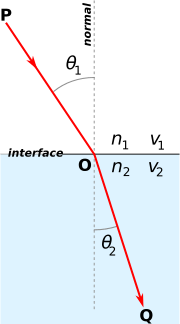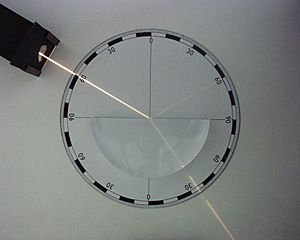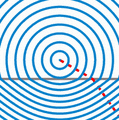Snell's law facts for kids

Snell's Law of Refraction is the scientific law of the refraction of light or other waves. In optics, Snell's law is about the speed of light in different media. The law states that when light passes through different materials (for example from air to glass) the ratio of sines of the incidence (incoming) angle and the refraction (outgoing) angle does not change:
With each  as the angle measured from the normal of the boundary,
as the angle measured from the normal of the boundary,  as the velocity of light in the respective medium (SI units are meters per second, or m/s).
as the velocity of light in the respective medium (SI units are meters per second, or m/s).  is the refractive index of the medium.
is the refractive index of the medium.
The index of refraction of a vacuum is 1 and the velocity of light in a vacuum is  . When a wave passes the material where the index of refraction is n, the velocity of the wave becomes
. When a wave passes the material where the index of refraction is n, the velocity of the wave becomes  .
.
Snell's law can be proved by Fermat's principle. Fermat's principle states that light travels along the path which takes the least time.
History
The idea has a long history. The problem had the attention of Hero of Alexandria, Ptolemy, Ibn Sahl, and Huygens. Ibn Sahl actually discovered the law of refraction. In Traité de la Lumiere, 1678, Huygens showed how Snell's law of sines could be explained by, or derived from, the wave nature of light.
Images for kids
-
Christiaan Huygens' construction
-
Wavefronts from a point source in the context of Snell's law. The region below the grey line has a higher index of refraction, and proportionally lower speed of light, than the region above it.
See also
 In Spanish: Ley de Snell para niños
In Spanish: Ley de Snell para niños








